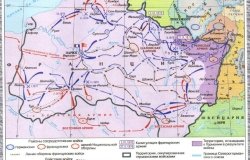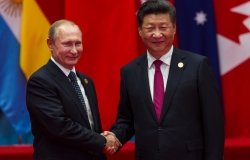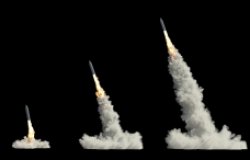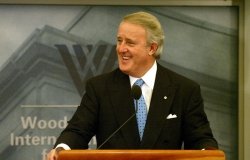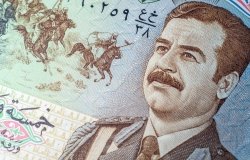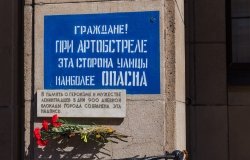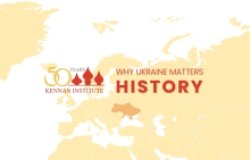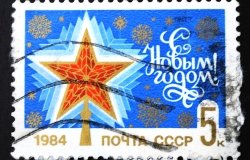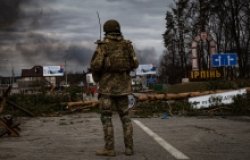Book Launch -- <i>The Jewish Enemy: Nazi Propaganda During World War II and the Holocaust</i>
With authorJeffrey Herf, Professor, Department of History, University of Maryland, College Park and former Woodrow Wilson Center Fellow; and Commentator Walter Reich, Yitzhak Rabin Memorial Professor, George Washington University, Woodrow Wilson Center Senior Scholar,and former Director of the United States Holocaust Memorial Museum
Overview
Book Launch -- The Jewish Enemy: Nazi Propaganda During World War II and the Holocaust
May 18, 2006
In her 1975 War Against the Jews, historian Lucy Dawidowicz revolutionized our understanding of the Holocaust by proposing that, for the Nazis, the Final Solution was not an independent phenomenon that occurred during World War II, but rather a part of it, like the Battle of the Bulge or the Eastern Front. At a Thursday, May 18, 2006 launch of his new book, Jewish Enemy: Nazi Propaganda During World War II and the Holocaust, hosted by the West European Studies Program and the History and Public Policy Program, University of Maryland professor and former Wilson Center Fellow Jeffrey Herf went even further, arguing that the war, in one sense, was an extension of the Holocaust.
The Nazi leadership interpreted World War II as a conflict launched and prolonged by "international Jewry"—an actual political entity "as real as the British parliament or U.S. Congress". In their view, International Jewry had formed the Grand Alliance to not only defeat the Reich, but, in the end, also eliminate all Germans. The Nazis perceived Jews in high profile and invisible positions of power in the American, British, and Russian governments. They could not separate the Allied war effort from their paranoia of a Jewish threat; hence the seemingly misplaced deepening of resentment and the acceleration of "retaliatory" cruelty towards the Jews as the Allied bombing inflicted ever increasing suffering upon Germans.
Nazi propaganda posters, exhibited by Herf, reflected this assessment. Stark, colorful, and distributed by the 100,000, these macabre caricatures of Roosevelt, Churchill, and Stalin conniving with and manipulated by real and imagined Jewish advisors and bankers, represented in many as "wire-pullers", to destroy the Reich would have been hard to ignore by that nation's largely pedestrian population. This propaganda presented any persecution of the Jews as a retaliatory measure by the innocent, threatened Germans.
In seeking to explain the origins of the Holocaust, Herf did not endorse the theory of a Sonderweg, or unique historical arc that led Germany inevitably to the Shoah. He recognized the existence of wide-spread anti-Semitism in Germany, but noted that, although it "created conditions for hate" and persecution, it "did not inspire mass murder." Due to lack of polling data and the complications involved in surveying personal opinion and "hate" in a totalitarian regime, it is impossible to measure the opinion on Jews by ordinary Germans and their knowledge of or complicity with Auschwitz and Treblinka.
Therefore, Herf decided, historians must study what Germans were told. Destruction of the free press was a precondition for the Holocaust, giving the government complete monopoly of the dissemination of information. The daily press conference at the Führer's office was merely a dictation of press directives and Hitler's spin on the news to assembled journalists. A decade-long constant retelling of the Jewish plot through every available media, with every newsworthy event woven into that intricate ideology as it was reported, had an impact on its audience, the millions of ordinary men and women of Germany. However, Herf also avoided the functionalist approach by some Shoah scholars, subscribing instead to a theory of "moderate intentionalism." The violently hateful ideology was inflicted upon the population by the Nazi leadership, as reflected by Hitler's personal hand in writing press directives.
Herf claims to have started new chapter in Holocaust historiography with his study of a subject hidden in plain view. Historians have ignored propaganda and press directives and speeches because they have been trained to treat official documents with skepticism. However, both the "euphemisms and the blunt speech" employed by Nazi leaders provide remarkable insights into their personal views—especially as the more repeated even a Big Lie is, the more its spokesperson will likely believe it. And outrageous statements, such as their constant threats to annihilate the Jews, disregarded by Allied powers early in the war, later proved genuine. The "public narrative" became policy, directed from on-high.
Dr. Walter Reich, Yitzhak Rabin Memorial Professor, George Washington University, Woodrow Wilson Center Senior Scholar, and former Director of the United States Holocaust Memorial Museum, lauded Herf's book as a "masterpiece of historical sleuthing." He agreed with Herf's assessment that Nazi propaganda was a "self-iterative enterprise" whose ultimate consequence was "extreme evil." A professor of psychiatry, Reich noted that it would have been "impossible for anyone who has eyes to see or ears to hear to ignore" the Nazi message. He cautiously drew a connection to current events, pointing to distinct echoes of those anti-Semitic threats in the recent statements of Iranian President Mahmoud Ahmadinejad, warning that, as Herf has shown, "fanatics really believe in their own fanaticism."
The Q&A featured a diverse range of questions, including Wilson Center Public Policy Scholar Nenad Canak's personal observation of parallels between the themes of victimhood and anti-Semitism in Nazi propaganda and the cries of national martyrdom and hate in state-controlled Serbian media under Slobodan Milosevic.
Drafted by Alton Buland, WES Program Assistant
Hosted By

Global Europe Program
The Global Europe Program is focused on Europe’s capabilities, and how it engages on critical global issues. We investigate European approaches to critical global issues. We examine Europe’s relations with Russia and Eurasia, China and the Indo-Pacific, the Middle East and Africa. Our initiatives include “Ukraine in Europe” – an examination of what it will take to make Ukraine’s European future a reality. But we also examine the role of NATO, the European Union and the OSCE, Europe’s energy security, transatlantic trade disputes, and challenges to democracy. The Global Europe Program’s staff, scholars-in-residence, and Global Fellows participate in seminars, policy study groups, and international conferences to provide analytical recommendations to policy makers and the media. Read more

Cold War International History Project
The Cold War International History Project supports the full and prompt release of historical materials by governments on all sides of the Cold War. Through an award winning Digital Archive, the Project allows scholars, journalists, students, and the interested public to reassess the Cold War and its many contemporary legacies. It is part of the Wilson Center's History and Public Policy Program. Read more

History and Public Policy Program
The History and Public Policy Program makes public the primary source record of 20th and 21st century international history from repositories around the world, facilitates scholarship based on those records, and uses these materials to provide context for classroom, public, and policy debates on global affairs. Read more
Thank you for your interest in this event. Please send any feedback or questions to our Events staff.
